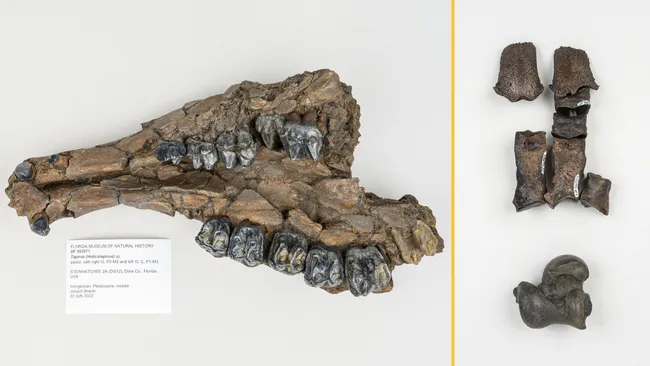Divers in Florida’s Steinhatchee River stumbled upon hundreds of pristine fossils from an obscure Ice Age period, including giant armadillos, ancient horses and possibly a new species of tapir.
Prehistoric Graveyard Unearthed in Florida’s Steinhatchee River
Fossil collectors have uncovered a prehistoric graveyard buried beneath Florida’s Steinhatchee River, revealing more than 500 fossils dating back approximately half a million years. This site has yielded an exceptionally well-preserved collection of ancient mammal remains, including horses, giant armadillos, sloths, and potentially a new species of tapir.
A Sinkhole Turned Time Capsule
Around 500,000 years ago, a sinkhole opened in Florida’s Big Bend region, becoming a death trap for countless animals. Over time, sediment filled the sinkhole, preserving their remains in near-pristine condition.
The fossils remained hidden until 2022, when fossil collectors Robert Sinibaldi and Joseph Branin discovered them during a routine diving expedition in the river’s murky waters. Branin first spotted horse teeth protruding from the sediment, which led the pair to uncover a hoof core and a tapir skull—indications of a potentially significant find.
“It wasn’t just quantity, it was quality,” Sinibaldi said in a statement released on Feb. 12 by the Florida Museum of Natural History. “We knew we had an important site, but we didn’t know how important.”
Recognizing the significance of the discovery, the Florida Museum dated the fossils to the middle of the Irvingtonian North American Land Mammal Age (1.6 million–250,000 years ago)—a period with a scarce fossil record.
“The fossil record everywhere, not just in Florida, is lacking the interval that the site is from,” explained Rachel Narducci, vertebrate paleontology collections manager at the Florida Museum and coauthor of a study published on Nov. 15 in the journal Fossil Studies.
Snapshots of Evolutionary Transitions
Among the most notable finds were fossils of Holmesina, an extinct, giant armadillo-like creature. Scientists have long known that Holmesina evolved from the 150-pound H. floridanus, which lived two million years ago, into H. septentrionalis, a species that grew to an astonishing 475 pounds. However, little fossil evidence existed to document this transition.
“It’s essentially the same animal, but over time, it got so much bigger, and the bones changed enough that researchers classified it as a different species,” Narducci explained.
The Steinhatchee River fossils provide a rare glimpse into this evolutionary shift. Ankle and foot bones found at the site exhibit a size comparable to the later, larger Holmesina species but retain traits of their smaller ancestors.
“This gave us more clues into the fact that the anatomy kind of trailed behind the size increase,” Narducci said. “So they got bigger before the shape of their bones changed.”
A Potentially New Species of Tapir?
Another intriguing discovery was the skull of an ancient tapir—a pig-shaped mammal with a short, elephant-like trunk. The skull exhibited features not previously recorded in the fossil record, prompting researchers to consider whether it belonged to a previously unknown species.
However, Richard Hulbert, the study’s lead author, urged caution. “We need more of the skeleton to firmly figure out what’s going on with this tapir,” he said. “It might be a new species, or it could just be an oddball individual of an existing population.”
Clues to an Ancient Landscape
Of the 552 fossils recovered, roughly 75% belonged to an early species of caballine horses—the subgroup that includes modern domestic horses.
Horses typically inhabit open grasslands rather than the dense forests that cover Florida’s Big Bend region today. Given their abundance in the fossil record at Steinhatchee River, researchers concluded that the area may have once been more open and grassy.
Horse teeth, among the best-preserved fossils, offer new insights into these ancient equines. “For the first time, we had individuals that were complete enough to show us upper teeth, lower teeth, and the front incisors of the same individual,” Hulbert noted. With visible wear and tear on the teeth, scientists may soon uncover unprecedented details about the horses’ diet.
A Window Into the Distant Past
The Steinhatchee River site provides a rare snapshot of a critical evolutionary period, helping scientists piece together how prehistoric species adapted over time. As researchers continue analyzing the fossils, they hope to unlock even more secrets about Florida’s ancient past.
